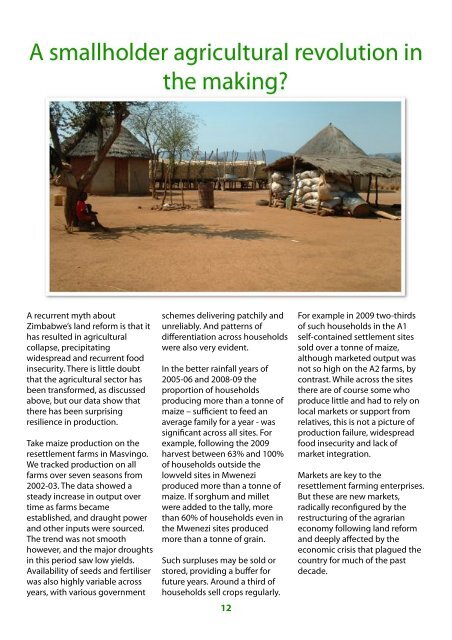Zimbabwe's Land Reform
Zimbabwe's Land Reform
Zimbabwe's Land Reform
Create successful ePaper yourself
Turn your PDF publications into a flip-book with our unique Google optimized e-Paper software.
A recurrent myth about<br />
Zimbabwe’s land reform is that it<br />
has resulted in agricultural<br />
collapse, precipitating<br />
widespread and recurrent food<br />
insecurity. There is little doubt<br />
that the agricultural sector has<br />
been transformed, as discussed<br />
above, but our data show that<br />
there has been surprising<br />
resilience in production.<br />
Take maize production on the<br />
resettlement farms in Masvingo.<br />
We tracked production on all<br />
farms over seven seasons from<br />
2002-03. The data showed a<br />
steady increase in output over<br />
time as farms became<br />
established, and draught power<br />
and other inputs were sourced.<br />
The trend was not smooth<br />
however, and the major droughts<br />
in this period saw low yields.<br />
Availability of seeds and fertiliser<br />
was also highly variable across<br />
years, with various government<br />
schemes delivering patchily and<br />
unreliably. And patterns of<br />
differentiation across households<br />
were also very evident.<br />
In the better rainfall years of<br />
2005-06 and 2008-09 the<br />
proportion of households<br />
producing more than a tonne of<br />
maize – sufficient to feed an<br />
average family for a year - was<br />
significant across all sites. For<br />
example, following the 2009<br />
harvest between 63% and 100%<br />
of households outside the<br />
lowveld sites in Mwenezi<br />
produced more than a tonne of<br />
maize. If sorghum and millet<br />
were added to the tally, more<br />
than 60% of households even in<br />
the Mwenezi sites produced<br />
more than a tonne of grain.<br />
Such surpluses may be sold or<br />
stored, providing a buffer for<br />
future years. Around a third of<br />
households sell crops regularly.<br />
12<br />
For example in 2009 two-thirds<br />
of such households in the A1<br />
self-contained settlement sites<br />
sold over a tonne of maize,<br />
although marketed output was<br />
not so high on the A2 farms, by<br />
contrast. While across the sites<br />
there are of course some who<br />
produce little and had to rely on<br />
local markets or support from<br />
relatives, this is not a picture of<br />
production failure, widespread<br />
food insecurity and lack of<br />
market integration.<br />
Markets are key to the<br />
resettlement farming enterprises.<br />
But these are new markets,<br />
radically reconfigured by the<br />
restructuring of the agrarian<br />
economy following land reform<br />
and deeply affected by the<br />
economic crisis that plagued the<br />
country for much of the past<br />
decade.

















